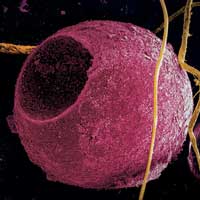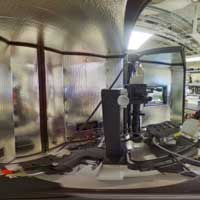 Researchers have managed to grow atomically thin films of molybdenum disulfide spanning up to several tens of square centimeters. It was demonstrated that the material's structure can be modified by varying the synthesis temperature.
Researchers have managed to grow atomically thin films of molybdenum disulfide spanning up to several tens of square centimeters. It was demonstrated that the material's structure can be modified by varying the synthesis temperature.
Wednesday, January 22, 2020
Physicist obtain atomically thin molybdenum disulfide films on large-area substrates
 Researchers have managed to grow atomically thin films of molybdenum disulfide spanning up to several tens of square centimeters. It was demonstrated that the material's structure can be modified by varying the synthesis temperature.
Researchers have managed to grow atomically thin films of molybdenum disulfide spanning up to several tens of square centimeters. It was demonstrated that the material's structure can be modified by varying the synthesis temperature.
Integrate micro chips for electronic skin
 Researchers present the first fully integrated flexible electronics made of magnetic sensors and organic circuits which opens the path towards the development of electronic skin.
Researchers present the first fully integrated flexible electronics made of magnetic sensors and organic circuits which opens the path towards the development of electronic skin.
Coating helps electronics stay cool by sweating
 Researchers present a MOF coating for electronics that releases water vapor to dissipate heat from running devices - a new thermal management method that could prevent electronics from overheating and keep them cooler compared to existing strategies.
Researchers present a MOF coating for electronics that releases water vapor to dissipate heat from running devices - a new thermal management method that could prevent electronics from overheating and keep them cooler compared to existing strategies.
Physicists trap light in nanoresonators for record time
 The reference particle captured light for a time exceeding 200 periods of one wave oscillation, 20-40 times longer than usual; this opens new perspectives in such areas as manufacturing compact sensors, night vision devices, and optical data transmission.
The reference particle captured light for a time exceeding 200 periods of one wave oscillation, 20-40 times longer than usual; this opens new perspectives in such areas as manufacturing compact sensors, night vision devices, and optical data transmission.
The quest for perfect quantum dot biomarkers
 Tiny nanoparticles can illuminate tissues and cells, but safer, more effective materials are needed before their mainstream application.
Tiny nanoparticles can illuminate tissues and cells, but safer, more effective materials are needed before their mainstream application.
Atomic force microscopy - Mapping the unseen
 Atomic force microscopy techniques enable scientists to map and modify material properties at the nanoscale for broad applications in energy, biology, medicine and beyond.
Atomic force microscopy techniques enable scientists to map and modify material properties at the nanoscale for broad applications in energy, biology, medicine and beyond.
Subscribe to:
Comments (Atom)
